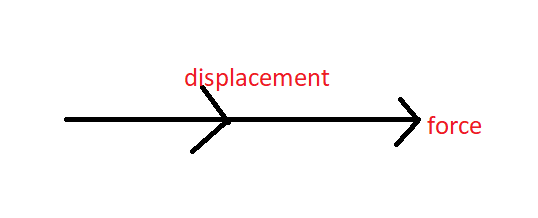
Explain positive, negative and zero work. Give one example of each.
Answer
592.2k+ views
Hint: Write formula of work $W=\overrightarrow{F}\cdot \overrightarrow{r}$. Learn dot product of two forces. For positive work, W should be positive so for this find an angle between force and displacement.
Dot product of two component A and B
$\overrightarrow{A}\cdot \overrightarrow{B}=AB\cos \theta $
Where $\theta $ is the angle between two vectors.
$\overrightarrow{F}\cdot \overrightarrow{r}=Fr\cos \theta $
Find $\theta $ for positive W, negative W and zero W.
Complete step by step answer:
The work done by a force on a particle during a displacement is given as
$W=\overrightarrow{F}\cdot \overrightarrow{r}$
Here, W = work
$\overrightarrow{F}$= force
$\overrightarrow{r}$= displacement
Positive work done – The work done is said to be positive when force and displacement are in the same direction.
$\begin{align}
& \theta ={{0}^{{}^\circ }} \\
& \overrightarrow{F}\cdot \overrightarrow{r}=Fr\cos \theta \\
& \overrightarrow{F}\cdot \overrightarrow{r}=Fr\cos {{0}^{{}^\circ }} \\
& \overrightarrow{F}\cdot \overrightarrow{r}=Fr \\
& W=\overrightarrow{F}\cdot \overrightarrow{r}=Fr \\
\end{align}$

Hence, work is positive.
Zero work – the work done is said to be zero when force and displacement are perpendicular to each other.
$\begin{align}
& \theta ={{90}^{{}^\circ }} \\
& \overrightarrow{F}\cdot \overrightarrow{r}=Fr\cos \theta \\
& \overrightarrow{F}\cdot \overrightarrow{r}=Fr\cos {{90}^{{}^\circ }} \\
& \overrightarrow{F}\cdot \overrightarrow{r}=0 \\
& W=\overrightarrow{F}\cdot \overrightarrow{r}=0 \\
\end{align}$
Hence, work is zero

Negative work done – The work done is said to be negative when force and displacement are in opposite directions.

$\begin{align}
& \theta ={{180}^{{}^\circ }} \\
& \overrightarrow{F}\cdot \overrightarrow{r}=Fr\cos \theta \\
& \overrightarrow{F}\cdot \overrightarrow{r}=Fr\cos {{180}^{{}^\circ }} \\
& \overrightarrow{F}\cdot \overrightarrow{r}=-Fr \\
& W=\overrightarrow{F}\cdot \overrightarrow{r}=-Fr \\
\end{align}$
Hence, work is negative.
Note: Work done by friction is always zero because friction force and displacement act in opposite directions. When a spring travels from A to B and from B back to A then work done during the return journey is negative of the work during the onwards journey and the net work done by the spring is zero.
Dot product of two component A and B
$\overrightarrow{A}\cdot \overrightarrow{B}=AB\cos \theta $
Where $\theta $ is the angle between two vectors.
$\overrightarrow{F}\cdot \overrightarrow{r}=Fr\cos \theta $
Find $\theta $ for positive W, negative W and zero W.
Complete step by step answer:
The work done by a force on a particle during a displacement is given as
$W=\overrightarrow{F}\cdot \overrightarrow{r}$
Here, W = work
$\overrightarrow{F}$= force
$\overrightarrow{r}$= displacement
Positive work done – The work done is said to be positive when force and displacement are in the same direction.
$\begin{align}
& \theta ={{0}^{{}^\circ }} \\
& \overrightarrow{F}\cdot \overrightarrow{r}=Fr\cos \theta \\
& \overrightarrow{F}\cdot \overrightarrow{r}=Fr\cos {{0}^{{}^\circ }} \\
& \overrightarrow{F}\cdot \overrightarrow{r}=Fr \\
& W=\overrightarrow{F}\cdot \overrightarrow{r}=Fr \\
\end{align}$

Hence, work is positive.
Zero work – the work done is said to be zero when force and displacement are perpendicular to each other.
$\begin{align}
& \theta ={{90}^{{}^\circ }} \\
& \overrightarrow{F}\cdot \overrightarrow{r}=Fr\cos \theta \\
& \overrightarrow{F}\cdot \overrightarrow{r}=Fr\cos {{90}^{{}^\circ }} \\
& \overrightarrow{F}\cdot \overrightarrow{r}=0 \\
& W=\overrightarrow{F}\cdot \overrightarrow{r}=0 \\
\end{align}$
Hence, work is zero

Negative work done – The work done is said to be negative when force and displacement are in opposite directions.

$\begin{align}
& \theta ={{180}^{{}^\circ }} \\
& \overrightarrow{F}\cdot \overrightarrow{r}=Fr\cos \theta \\
& \overrightarrow{F}\cdot \overrightarrow{r}=Fr\cos {{180}^{{}^\circ }} \\
& \overrightarrow{F}\cdot \overrightarrow{r}=-Fr \\
& W=\overrightarrow{F}\cdot \overrightarrow{r}=-Fr \\
\end{align}$
Hence, work is negative.
Note: Work done by friction is always zero because friction force and displacement act in opposite directions. When a spring travels from A to B and from B back to A then work done during the return journey is negative of the work during the onwards journey and the net work done by the spring is zero.
Recently Updated Pages
Why are manures considered better than fertilizers class 11 biology CBSE

Find the coordinates of the midpoint of the line segment class 11 maths CBSE

Distinguish between static friction limiting friction class 11 physics CBSE

The Chairman of the constituent Assembly was A Jawaharlal class 11 social science CBSE

The first National Commission on Labour NCL submitted class 11 social science CBSE

Number of all subshell of n + l 7 is A 4 B 5 C 6 D class 11 chemistry CBSE

Trending doubts
What is meant by exothermic and endothermic reactions class 11 chemistry CBSE

10 examples of friction in our daily life

One Metric ton is equal to kg A 10000 B 1000 C 100 class 11 physics CBSE

1 Quintal is equal to a 110 kg b 10 kg c 100kg d 1000 class 11 physics CBSE

Difference Between Prokaryotic Cells and Eukaryotic Cells

What are Quantum numbers Explain the quantum number class 11 chemistry CBSE




